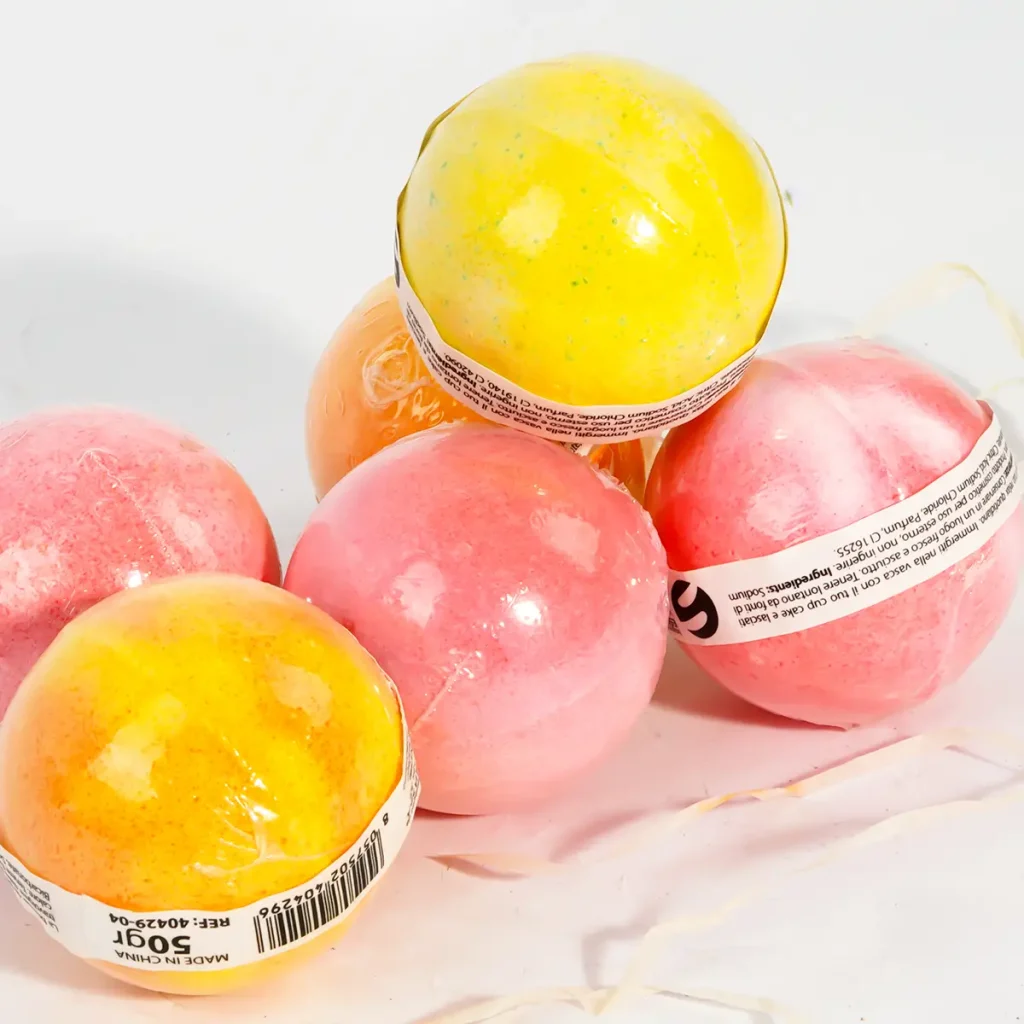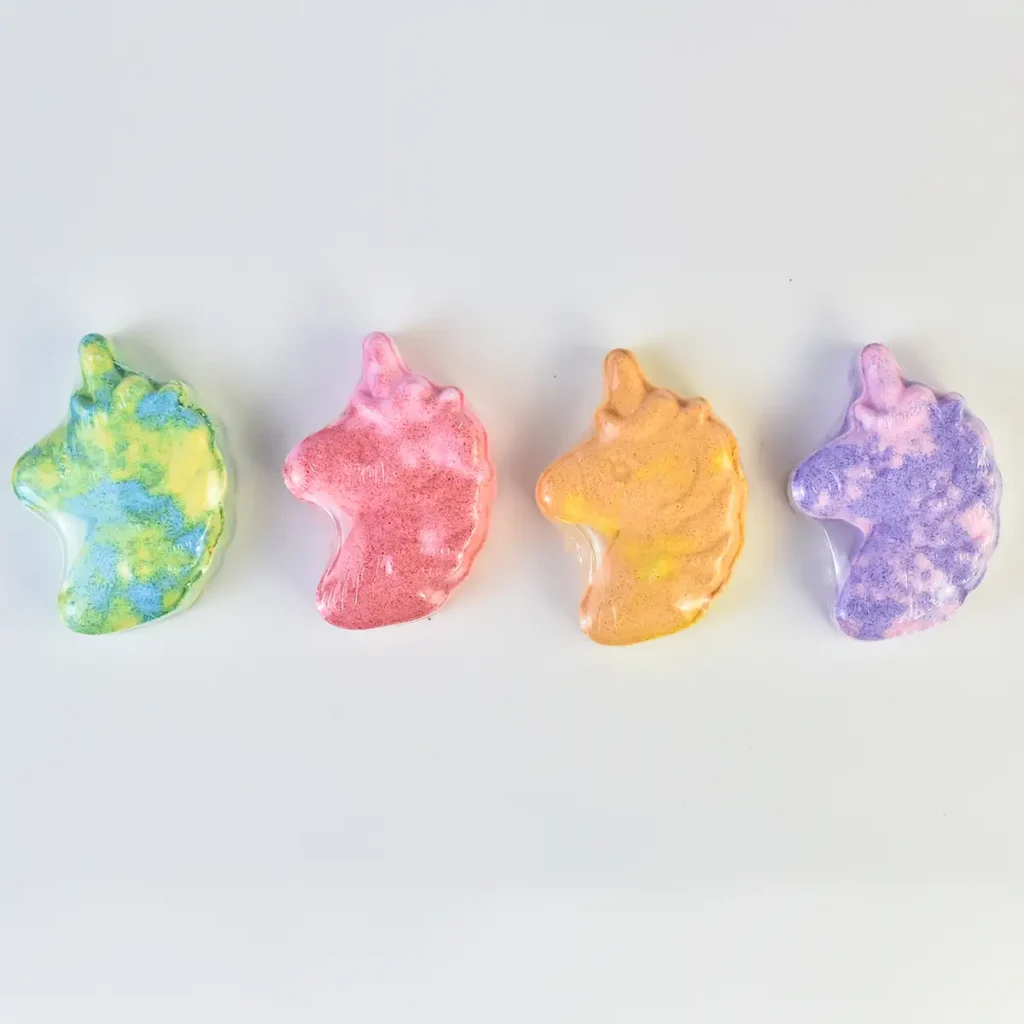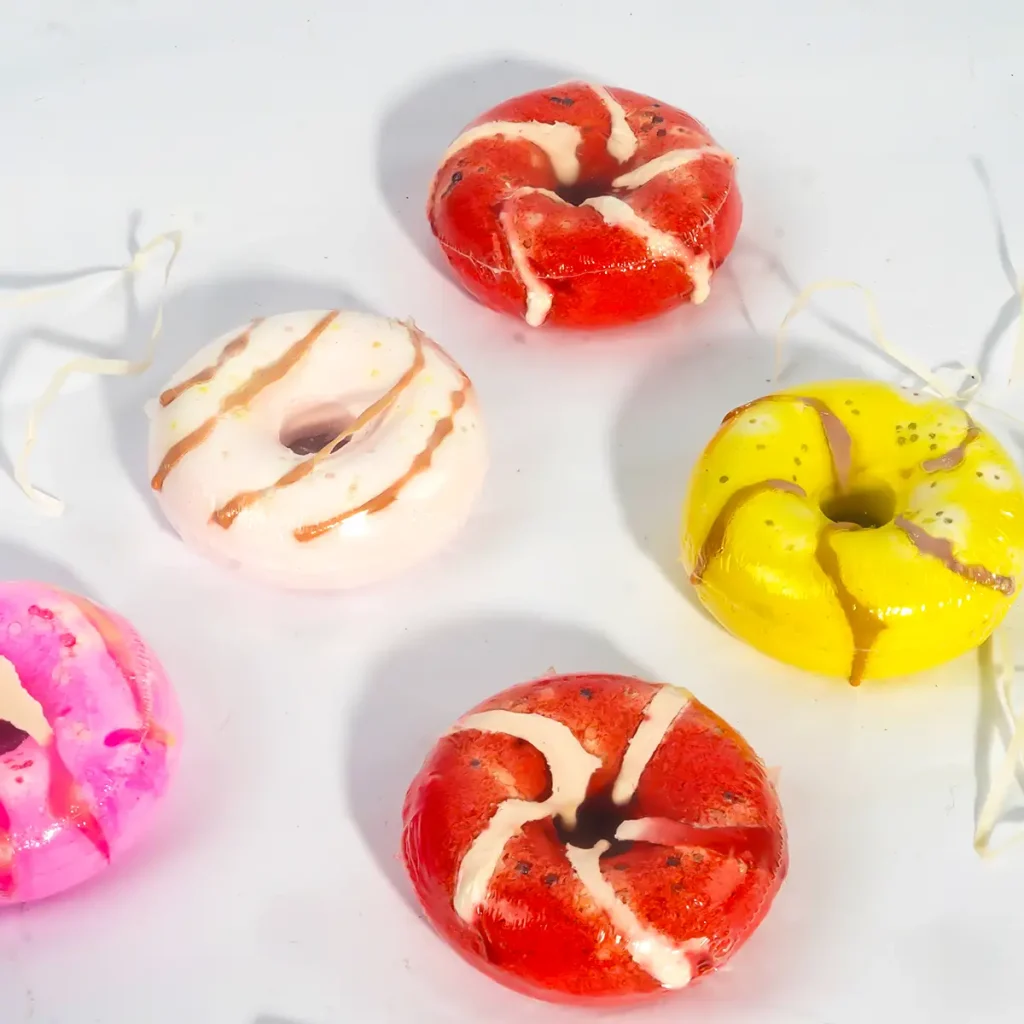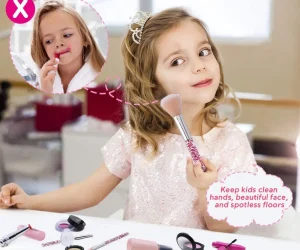Are Bath Bombs OK for Kids’ Skin? A Look at Safety and Science
Table of Contents
Bath bombs may look like toys, but they’re actually tiny chemistry sets. When dropped into warm water, they fizz, swirl, and release scent and color—but what’s really in them?
Common Ingredients in Standard Bath Bombs
Most bath bombs are made with three basic things: baking soda (sodium bicarbonate), citric acid, and a filler like cornstarch or Epsom salts. These are dry powders that only react when wet. Baking soda and citric acid are safe when used properly and often found in food.
Some bombs also use oils like coconut or almond to soften skin. While these can be soothing, they might not suit all kids—especially those with allergies or eczema.
How These Ingredients React in Water
The fizzing comes from a chemical reaction. When baking soda and citric acid touch water, they make carbon dioxide bubbles. That’s the fun part.
This reaction is quick but harmless. It doesn’t heat up, explode, or damage skin. However, if a bath bomb includes too much acid or harsh surfactants, it can mess with skin pH or cause dryness over time.
Also, water temperature matters. Hot water may make the reaction more intense and could irritate sensitive skin. Lukewarm water is usually best for kids.
Fragrance, Colorants, and Additives: What to Know
Fragrances and dyes make bath bombs exciting—but they’re also where most skin problems come from. Artificial scents can contain dozens of hidden chemicals, some of which may irritate young skin or trigger allergies.
Colors are usually made from FD&C dyes. While many are approved for cosmetic use, not all are gentle on sensitive skin. Red and blue dyes, in particular, have been linked to mild irritation in some kids (FDA, 2020).
Some bombs also include glitter, dried flowers, or foaming agents. These aren’t dangerous in small amounts, but they can leave residue or even clog drains. More importantly, rough particles or preservatives can upset a child’s skin balance, especially if used often.
How Children’s Skin Differs from Adults’
At first glance, children’s skin may seem smooth and resilient, but biologically, it tells a different story. Compared to adult skin, it’s thinner, more delicate, and far less experienced in defending itself.
Skin Barrier Maturity and Sensitivity
Children are born with an underdeveloped skin barrier. This layer—made of lipids and cells—acts like a shield against bacteria, toxins, and moisture loss. In babies and young kids, it’s still forming.
Because of this, substances that might not bother an adult can absorb more easily into a child’s skin. Even mild ingredients can sometimes sting, dry out, or trigger a reaction. Friction, strong soaps, or scented products may all become irritants simply because the shield isn’t fully ready.
In short, what sits harmlessly on adult skin might pass deeper into a child’s.
Common Skin Conditions in Children
Children also face different skin challenges than adults. Eczema is especially common, with up to 20% of children affected worldwide (National Eczema Association, 2023). Sensitive skin, diaper rash, and contact dermatitis are also frequent visitors in childhood.
Some kids have skin that looks fine but reacts unpredictably to certain ingredients. Artificial dyes, preservatives, or essential oils can become triggers—not because they’re inherently dangerous, but because young skin isn’t great at handling surprises.
That’s why pediatric dermatologists often recommend gentle, fragrance-free formulas during early childhood.
Why Ingredients Matter More for Younger Skin
In cosmetics and personal care, “natural” or “organic” doesn’t always mean safe—especially for kids. Some botanical ingredients, like citrus oils or lavender, can be harsh on young skin, even if they’re plant-based.
It’s not about avoiding every chemical. It’s about knowing which ones are safe, stable, and non-irritating. Simpler is often better. Fewer ingredients usually mean fewer chances for skin to misbehave.
Ultimately, when choosing bath bombs or any skin product for a child, it helps to think like a botanist: curious, cautious, and always looking beneath the surface.
Are Bath Bombs Safe for Kids with Sensitive Skin or Allergies?
For parents of kids with sensitive skin, bath time can be both soothing and risky. While bath bombs seem fun and fizzy, not all are suitable for children prone to allergies or skin irritation. The key is knowing what to watch out for—and how to respond if something goes wrong.
Common Irritants to Avoid in Bath Bombs
Not all ingredients in bath bombs are harsh, but a few do raise red flags for sensitive skin. Artificial fragrances are among the most common irritants. These scent blends can contain dozens of undisclosed chemicals, many of which can trigger redness or itch.
Synthetic colorants, especially lake dyes or FD&C colors, may also pose a risk. While generally approved for use, they can cause irritation in children with reactive skin. Glitter—whether plastic or mica-based—is often more of a mechanical irritant than a chemical one, especially if it lingers on the skin or gets into small scratches.
Finally, some natural ingredients like citrus oils, cinnamon, or menthol can sting or dry out skin—particularly if the child has eczema.
Signs of a Mild Reaction vs. Serious Irritation
A mild reaction might look like faint redness, dryness, or a few small bumps after bathing. This often fades within an hour and may not bother the child. It’s the skin’s way of saying, “That didn’t feel great.”
More serious signs include intense itching, swelling, hives, or blistering. These can appear right after contact—or several hours later. If your child complains about burning, stinging, or shows signs of respiratory distress, rinse them off immediately and contact a healthcare provider.
Keeping a mental (or written) list of products used before a reaction helps identify the culprit more easily.
Hypoallergenic vs. Non-toxic: What’s the Difference?
These two labels are often confused, but they mean different things. Hypoallergenic suggests a product is less likely to cause an allergic reaction. However, this term isn’t tightly regulated in most countries, so always check the full ingredient list.
Non-toxic means the product shouldn’t cause harm if used as intended, but it doesn’t guarantee it’s allergy-safe or irritation-free. A bath bomb might be non-toxic but still contain ingredients that cause redness or itch in sensitive users.
For kids with known allergies or very reactive skin, unscented and dye-free options tend to be the safest bets—even if they lack the drama of fizz and color.
The Role of pH and Acidity in Skin Health
Skin may seem tough, but it’s actually protected by a thin, invisible layer called the acid mantle. This layer keeps moisture in and harmful bacteria out. When the pH of products like bath bombs shifts too far from skin’s natural range, it can upset that balance—especially for kids, whose skin is still developing.
How Bath Bomb pH Affects Skin
Bath bombs fizz because of a reaction between a base (usually baking soda) and an acid (like citric acid). When these mix in water, they create carbon dioxide bubbles. It’s fun—but it also means bath bombs are slightly acidic.
This mild acidity isn’t always harmful. But if the final mixture is too acidic or too alkaline, it can irritate the skin, especially in children. An overly acidic solution might sting cuts or rashes, while a high pH (more alkaline) could strip away natural oils and make the skin dry or itchy.
pH isn’t usually listed on product labels. But bath bombs made with balanced ratios, fewer harsh additives, and tested formulas are less likely to disrupt skin.
Ideal pH for Children’s Bath Products
Healthy skin has a pH between 4.5 and 5.5—slightly acidic. This level helps maintain the skin barrier and supports friendly microbes that keep bad bacteria in check.
Children’s bath products should aim to be close to that range. Products with a neutral or slightly acidic pH (4–7) are generally better tolerated. Bath bombs that stay within this range after dissolving in water are less likely to cause irritation.
If you’re unsure, a pH test strip (sold at pharmacies or online) can help you check the water after the bomb dissolves. It’s a small step, but for kids with sensitive skin, it can make a big difference.
Natural vs. Synthetic: What’s Better for Kids?
Children’s products often carry the label “natural” to suggest they’re gentler or safer. But the line between natural and synthetic ingredients isn’t always clear—and it’s not always meaningful. When it comes to kids’ skin, what matters more is how an ingredient behaves on the body, not where it came from.
Are “Natural” Ingredients Always Safer?
Just because something is natural doesn’t mean it’s harmless. Poison ivy is natural—but you wouldn’t want it in a bath. Some natural ingredients, like baking soda or coconut oil, are generally well tolerated. Others, like certain plant extracts, can trigger allergic reactions.
Synthetic ingredients, on the other hand, are made in labs to mimic or improve on natural versions. They’re often more stable, more predictable, and easier to test for safety. Many are used in very small amounts and are strictly regulated in children’s products.
So, rather than focusing on whether something is “natural,” it’s better to ask: Has this ingredient been tested for use on children’s skin?
The Truth About Essential Oils and Botanicals in Kids’ Baths
Essential oils like lavender, eucalyptus, or tea tree are common in bath bombs labeled “natural.” While these oils sound gentle, they are highly concentrated plant extracts—and not all are safe for kids.
For example, eucalyptus and peppermint oils can affect breathing in young children. Citrus oils may make the skin more sensitive to sunlight. Even lavender, which is often seen as soothing, can cause irritation or hormonal effects when overused.
Botanicals like rose petals or chamomile might look pretty floating in the tub, but they can also carry pollen or residual compounds that irritate sensitive skin. Dried flowers can even clog drains or harbor mold if not dried properly before use.
So when considering “natural” bath bombs for kids, always check which ingredients are included and in what amount. What smells nice to adults may be too strong for a child’s thinner, more sensitive skin.
How to Read Bath Bomb Labels Like a Pro
Not all bath bombs are created equal—especially when it comes to what’s inside them. For parents, knowing how to read a product label is a powerful way to make safer choices. It’s not just about avoiding long, scary-sounding words. It’s about understanding what those words mean, and how they might affect a child’s skin.
Ingredients to Look For
When scanning a bath bomb label, you’ll want to see gentle, well-tolerated ingredients. Sodium bicarbonate (baking soda) and citric acid are common base ingredients—they help create the fizz but are generally mild.
Other friendly additions might include:
- Colloidal oatmeal – helps soothe dry or irritated skin.
- Coconut-derived surfactants – a mild way to add bubbles without harsh sulfates.
- Natural starches – like corn or arrowroot, which can soften the bath water.
Plant oils like sweet almond oil or sunflower oil can be beneficial, especially if they’re cold-pressed and added in small amounts. They help with moisture but shouldn’t overpower the formula.
Ingredients to Be Cautious About
Some ingredients deserve a closer look. While not always harmful, they can be irritating—especially on young, delicate skin.
Watch out for:
- Artificial dyes and colorants – Bright colors might look fun but can trigger reactions in sensitive kids.
- Fragrance (parfum) – This term often hides a mix of undisclosed chemicals. If possible, choose products labeled “fragrance-free” or “naturally scented.”
- Preservatives like methylisothiazolinone (MI) – Often found in personal care products, MI has been linked to skin allergies.
- Glitter or mica – Shiny elements can scratch skin or be tough to rinse off, especially if they’re plastic-based.
Just because an ingredient is used in adult bath bombs doesn’t mean it’s ideal for kids.
Understanding Certifications and Claims
Bath bomb labels might include a range of terms: “hypoallergenic,” “non-toxic,” “dermatologist-tested,” or “eco-friendly.” But not all of these are regulated.
Here’s what to know:
- “Hypoallergenic” means the product is less likely to cause allergic reactions—but there’s no universal test. It’s wise to patch-test anyway.
- “Non-toxic” means it won’t cause serious harm if used as directed, but it doesn’t guarantee it won’t irritate the skin.
- Look for certifications from trusted bodies like the Environmental Working Group (EWG) or seals such as USDA Organic, NSF, or Made Safe for added assurance.
Even if a bath bomb looks playful and safe, reading the fine print helps avoid surprises.
Are DIY Bath Bombs Safer for Children?
Not all store-bought bath bombs are made with children’s skin in mind. That’s why some parents turn to homemade options. But does making your own really mean it’s safer? It depends on how you do it, and what goes into the recipe.
Pros and Cons of Making Bath Bombs at Home
Pros
Making bath bombs at home gives you full control. You choose the ingredients, skip harsh chemicals, and leave out artificial dyes or strong fragrances. That’s great for kids with sensitive skin. It’s also a fun craft project—especially when kids help make them (with adult supervision, of course).
You can tailor the formula based on your child’s needs. Dry skin? Add a few drops of mild plant oil. Sensitive to scent? Go scent-free or use calming, kid-safe options like lavender hydrosol.
Cons
However, DIY isn’t always foolproof. Not all homemade recipes are skin-safe. Some online tutorials use ingredients like citric acid in high amounts, or essential oils without proper dilution. There’s also the risk of contamination if tools or containers aren’t clean.
Another downside? Homemade bath bombs may not have preservatives. That means they can spoil or grow mold if stored in a humid space, especially when made with natural additives like fruit powders or milk.
Kid-Friendly Formulas and What to Avoid
A basic, gentle formula for children should include:
- Baking soda
- Citric acid (used sparingly)
- Cornstarch or arrowroot powder (for soft texture)
- Carrier oil like sweet almond, jojoba, or coconut
- Distilled water or witch hazel for binding
If you want to add a scent, choose essential oils cautiously. Lavender and chamomile are usually safer—but use only 1 drop per bomb and mix with a carrier oil. Avoid strong oils like peppermint, tea tree, or citrus, which can irritate young skin.
Skip:
- Glitter (especially plastic-based)
- Artificial fragrances
- Strong dyes or mica powders
- Preservatives or unknown emulsifiers
Lastly, always test the final product on a small patch of your child’s skin before tossing it into a full bath. A fizz is fun—but safety comes first.
Expert Opinions and Pediatric Dermatologist Advice
When it comes to children’s skincare, especially products like bath bombs, expert voices matter. Pediatric dermatologists often weigh in with cautious but clear advice.
What Dermatologists Say About Bath Bomb Use for Kids
Most pediatric dermatologists agree: bath bombs aren’t strictly unsafe, but they aren’t necessary either. According to the American Academy of Dermatology (AAD), bath products with added fragrance or colorants can increase the risk of skin irritation—especially in children under 6, whose skin barrier is still developing.
Dr. Angela Diaz, a pediatric dermatologist based in Chicago, explains that ingredients like artificial dyes, strong essential oils, and foaming agents can trigger eczema flare-ups or allergic reactions in sensitive kids. “If a child already has dry skin or eczema, bath bombs might do more harm than good,” she says.
Still, some experts say the occasional use of a very gentle bath bomb may be fine—especially if the product is free from common irritants and followed by moisturizing right after the bath.
Recommendations for Frequency and Age Suitability
Most experts suggest limiting bath bomb use to once per week at most, and only for children over the age of 3. For toddlers or infants, simpler baths with plain water or mild cleansers are best.
Dermatologists also recommend:
- Short bath times (10–15 minutes max)
- Lukewarm water (hot water increases skin dryness)
- Moisturizing immediately after the bath to help seal the skin barrier
For children with a history of rashes, allergies, or eczema, many dermatologists suggest skipping bath bombs altogether—or at least doing a patch test before full use.
In short, while bath bombs can be fun, they should be treated more like a rare treat than a daily bath essential. And if in doubt, it’s always worth checking with your child’s doctor or dermatologist first.
What Parents Should Watch For During and After Bath Time
Bath time is fun, but parents need to stay alert. Observing how a child’s skin reacts during and after the bath helps prevent problems before they start.
Patch Testing and Trial Use
Before using a bath bomb fully, try a patch test. Apply a small amount of the dissolved product to a tiny area of your child’s skin—like the forearm—and wait 24 hours. If redness, itching, or swelling appears, avoid that product.
When introducing any new bath product, start with a short bath and watch your child closely. Keep notes about the product used, water temperature, and any skin changes for future reference.
When to Stop Use and Seek Medical Advice
If your child shows persistent redness, swelling, blistering, or severe itching after bath time, stop using the bath bomb immediately. These can be signs of an allergic reaction or dermatitis.
Seek medical advice if symptoms worsen or don’t improve after a day or two. Also, if your child experiences breathing difficulties or swelling of the face and throat, get emergency care right away.
Creating a Safer Bath Time Routine for Children
Parents can make bath time both safe and enjoyable by choosing gentle products and adding creative touches that don’t irritate skin.
Alternatives to Bath Bombs
Simple options like oatmeal baths, plain baking soda, or mild, fragrance-free bubble baths can soothe and clean skin without causing irritation. These alternatives are especially good for children with eczema or very sensitive skin
Tips for Making Bath Time Fun Without Irritants
Try colorful bath toys, floating animals, or water-safe books to entertain your child. Adding a small amount of food coloring or natural flower petals (without strong scents) can also create excitement without harsh chemicals.
Encourage your child to splash and play gently, and keep bath time to 10–15 minutes to avoid drying out the skin.
Environmental and Skin Health Connection
Choosing bath products wisely can protect not just your child’s skin but also the planet.
Are Kids’ Bath Bombs Eco-Friendly?
Many bath bombs contain ingredients like synthetic glitter or non-biodegradable dyes that harm waterways and wildlife when washed down drains. Eco-friendly bath bombs use biodegradable components and natural colors to reduce this impact.
Checking for “plastic-free” or “biodegradable” labels can guide you toward greener choices.
How Ingredients Can Affect Both Skin and Water Systems
Harsh chemicals, preservatives, and artificial fragrances can irritate skin and pollute water systems. Once rinsed, they enter rivers and lakes, affecting aquatic life.
Choosing bath bombs with natural, non-toxic ingredients helps protect your child’s skin and the environment. This thoughtful approach supports healthier skin and a healthier planet.
Conclusion
Bath bombs can add fun to bath time, but not all are safe for kids’ sensitive skin. Understanding ingredients, testing products carefully, and choosing gentle options help protect children’s skin health. Always prioritize safety and consult experts when in doubt.
FAQ
Yes, some bath bombs contain ingredients like citric acid and baking soda that can disrupt the skin’s natural oils. This may lead to dryness, especially if used frequently or in hot water. It’s best to moisturize your child’s skin after bath time and limit bath bomb use to avoid excessive dryness.
Glitter in bath bombs is often made from tiny plastic particles, which can irritate sensitive skin or eyes. Additionally, plastic glitter is harmful to the environment. If you want to use glitter bath bombs, opt for ones with biodegradable or natural mica glitter and always rinse your child thoroughly afterward.
To protect delicate skin, children should stay in the bath for no more than 10 to 15 minutes. Longer exposure, especially in warm water with bath bombs, can cause skin to dry out or become irritated. Always monitor your child and adjust bath time according to their skin’s response.
Children with eczema have sensitive skin that can react to many ingredients in bath bombs, such as fragrances, dyes, or acids. It’s generally recommended to avoid bath bombs or use only fragrance-free, dye-free, and hypoallergenic versions. Consulting a dermatologist before use is important for eczema-prone skin.
Store bath bombs in a cool, dry place away from moisture and direct sunlight. Exposure to humidity can cause them to activate prematurely or develop mold. Keeping them in airtight containers helps maintain their quality and ensures they stay safe for your child’s bath time.










